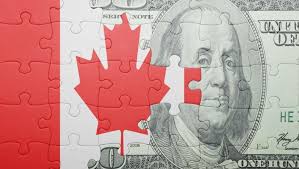The USD/CAD pair continued its downward trajectory
The USD/CAD pair continued its downward trajectory, falling to 1.3650 during Friday’s European session. This decline reflects a broader weakness in the US Dollar, which has struggled to gain ground amidst growing anticipation of the US core Personal Consumption Expenditure (PCE) Price Index data for April. The PCE data, a key measure of inflation, is set to be released at 12:30 GMT and is expected to show a steady rise of 0.3% monthly and 2.8% annually.
Impact of Revised US Q1 GDP Growth
Adding to the pressure on the US Dollar was the recently revised estimate of the US Q1 Gross Domestic Product (GDP) growth. The US Bureau of Economic Analysis (BEA) reported that the economy expanded at a slower pace of 1.3%, down from the preliminary estimate of 1.6%. This downward revision has bolstered hopes that the Federal Reserve (Fed) might cut interest rates at least once this year. A reduction in interest rates would typically weaken the US Dollar as lower rates reduce the return on investments denominated in the currency.
Market Expectations and PCE Data
The forthcoming PCE data is crucial for market participants as it could influence the Fed’s interest rate decisions. If the data shows inflation rising as expected, it could weaken the case for a rate cut in the near term, which would typically support the US Dollar and bond yields. Conversely, if the inflation data falls short of expectations, it would strengthen the case for rate cuts, potentially further weakening the US Dollar. Currently, the US Dollar Index (DXY), which measures the currency’s value against a basket of six major currencies, is subdued around 104.75.
Broader Market Sentiment
Market sentiment remains broadly risk-averse, influenced by disappointing economic data from China. The latest Manufacturing and Non-Manufacturing Purchasing Managers’ Index (PMI) data from China has raised concerns about global economic prospects, contributing to a cautious market environment. This risk aversion is evident in the performance of the S&P 500 futures, which have posted losses during the European session.
Canadian Dollar and Domestic Economic Data
On the other side of the USD/CAD pair, the Canadian Dollar is being influenced by domestic economic data. Canada is also set to release its monthly and Q1 GDP data at 12:30 GMT. The Canadian economy is forecasted to have remained stagnant in March, following a 0.2% expansion in February. Weak GDP data could heighten expectations that the Bank of Canada (BoC) might start reducing interest rates from its June meeting. Such expectations could put further downward pressure on the Canadian Dollar, potentially offsetting some of the weakness in the US Dollar.
Technical Analysis and Key Levels
Technically, the USD/CAD pair is currently trading at 1.3653, having opened the day at 1.3681. The pair has seen a daily change of -0.20%, with a low of 1.366 and a high of 1.3735 in the previous session. Key technical levels include:
- Daily Simple Moving Averages (SMA):
- SMA20: 1.3667
- SMA50: 1.366
- SMA100: 1.3577
- SMA200: 1.3575
- Pivot Points:
- Support levels: S1 at 1.3649, S2 at 1.3617, and S3 at 1.3574
- Resistance levels: R1 at 1.3724, R2 at 1.3767, and R3 at 1.3799
- Previous Highs and Lows:
- Previous daily high: 1.3735
- Previous daily low: 1.366
- Previous weekly high: 1.3744
- Previous weekly low: 1.3596
- Previous monthly high: 1.3846
- Previous monthly low: 1.3478
- Fibonacci Levels:
- 38.2% retracement at 1.3689
- 61.8% retracement at 1.3706
Conclusion
The USD/CAD pair’s recent decline to 1.3650 underscores the current challenges facing the US Dollar amidst economic data releases and market sentiment. The upcoming core PCE Price Index data will be a critical indicator for the Fed’s future monetary policy decisions. Meanwhile, the Canadian Dollar remains sensitive to its own domestic economic data, with potential implications for the BoC’s interest rate policies. Traders and investors will be closely watching these developments as they navigate the current market landscape.
By understanding these dynamics and keeping an eye on key technical levels, market participants can better position themselves to respond to potential shifts in the USD/CAD pair’s trajectory
